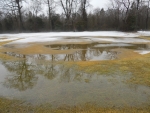
Peter H. Dernoeden, Ph. D.
Timing is everything when it comes to weeds. For most golf courses in our area, there has been way below average play due to lousy weather. The bottom line has bottomed-out and cash flow is a problem. Some golf courses found enough of a window to core and topdress greens, but the cold weather has prevented much in the way of hole closure. The result has been far fewer golfers on days when even the “cold weather” regulars would play. The problem associated with coring and heavy sand topdressing is mostly visual for the average golfer. Properly done, cored-topdressed greens play remarkably well and summer benefits outweigh any late winter bumps and distortions.
March is supposed to “Come In Like a Lion and Go Out Like a Lamb.” March is a transition month, which usually delivers a combination of nasty and nice weather. This year, however, March has been mostly cloudy, rainy, marked by consistently below average air temperatures, and what seemed like unrelenting wind. Three Nor’easters brought gale-force winds knocking down trees and scattering tree debris. The forth Nor’easter arrived the first two days of spring (i.e., March 20 and 21) and brought sleet and snow.

A question being asked by LCO’s is “how will all of this cold and wet weather” impact their preemergence applications? Because preemergence herbicides are degraded mostly by microbial activity (which require warm soils), any applications in March will not be impacted significantly due to heavy rain or snow. In over 30 years of observation at the University of Maryland in College Park near D.C., I noted that crabgrass almost always germinates April 15 ± 7 days, regardless if it has been a warm or cold March. Early crabgrass germination is sparse and most preemergence herbicides will kill any tiny plants that have emerged before mid-April. The big surge in crabgrass emergence does not happen until about mid-May in the Philadelphia – Washington DC corridor. Regardless, preemergence herbicides should be applied by early April for best results.
Tall fescue lawns and roughs are brown from a distance and look like dormant bermudagrass. Homeowners are asking what can be done to green-up their lawnsand will there be much recovery of turf damaged by dog trails in the back yard. That dead looking turf in the dog run areas will recover as well as the rest of the lawn in a few weeks. Some water soluble nitrogen (i.e., 0.50-0.75 lb N/ 1000 ft2) will help to stimulate a more rapid green-up. Coring would be helpful in low areas where water puddles and in areas compacted by dogs. Pesky moles and voles already are tunneling and mounding, mostly in lawns adjacent to wooded areas. I have heard stories about effective mole/vole control with castor oil, cayenne pepper, steel wool and baits, but they work only after moles/voles have moved away. Using insecticides to target grub insects is another mythological approach to mole and vole control. Harpoon traps, and tunnel-guns that shoot blanks, sometimes are effective, but only when main tunnels are being actively used by these varmints. Most homeowners do not have the time and patience for these devices, and again, moles and voles move around too much for these traps to be highly effective. These critters are after a wide array of earthworms, insects and other invertebrates and they will leave in their own good time. In the meanwhile, just tamp down the tunnels and redistribute mounded soil.
Finally sod producers are put on an indefinite hold for spring planting and weed control chores. Following the late March snow, it will take time to melt and drain soils sufficiently to get equipment into fields.
 Dr. Pete's Turf Tips
Dr. Pete's Turf Tips